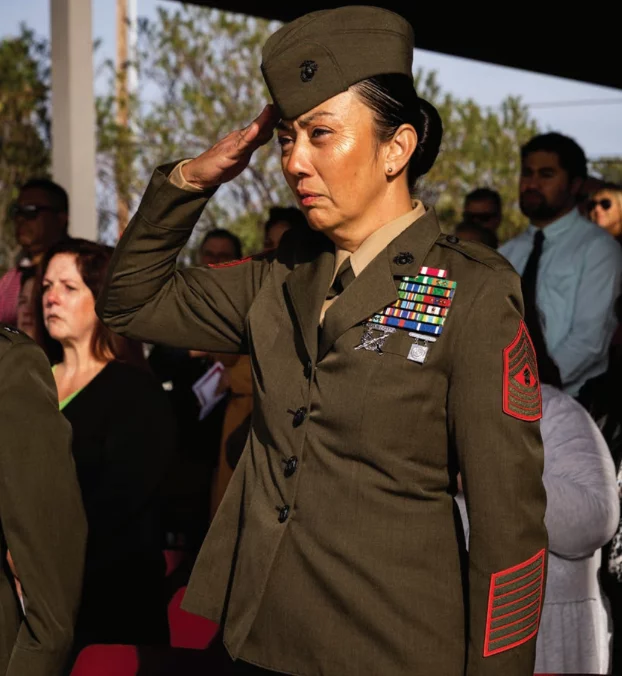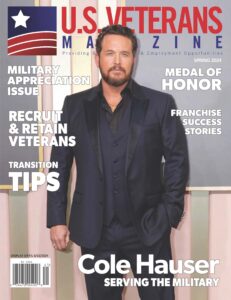“Women veterans are a strong group of people. They worked hard, deployed, raised families and sacrificed their time, energy and selves to earn their ranks, titles and places in history books that have not yet been written.
Women have great instincts and deserve a seat at every table, in every boardroom, at every town hall meeting and at any discussion where decisions need to be made. Women have always been an integral part of society and [the] future of the world. It’s time that women are put out front to receive the recognition of all the decades of hard work that has been put in to establish a legacy in the armed forces.” -retired Master Gunnery Sergeant Carla Perez, USMC
Let’s meet one of these esteemed women, 28-year USMC veteran retired Master Gunnery Sergeant Carla Perez. MGySgt Perez began her career in the Marines on May 17, 1993, and retired on December 31, 2021. Her service included three deployments: Bosnia in 1996, Iraq in 2008-2009 and Afghanistan in 2010-2011. She was stationed in many places around the globe, including 29 Palms, California; Iwakuni, Japan; Camp Pendleton, California; Vancouver, Washington; Marine Corps Air Station, Mira Mar in San Diego and Camp Lejeune, North Carolina.
 Although Perez was raised in a family of veterans, the military was not initially in her plans. She graduated high school and went on to college at the University of Montana but returned home to Oregon when she didn’t have the funds to continue her studies. There, she worked a few odd jobs until a recruiter found her and offered her the opportunity to join the Marine Corps. You can say the rest is history!
Although Perez was raised in a family of veterans, the military was not initially in her plans. She graduated high school and went on to college at the University of Montana but returned home to Oregon when she didn’t have the funds to continue her studies. There, she worked a few odd jobs until a recruiter found her and offered her the opportunity to join the Marine Corps. You can say the rest is history!
While serving in the Marines, Perez found that women progressed in the Marine Corps in both rank and job opportunities at a fair rate. She never felt as though being a woman held her back. Previously closed jobs in the combat arms MOS had opened, and women were assigned to traditionally male units. Early in that transition, women were doing combat supporting jobs, admin, supply
 In 2008 for one year as their Logistics/Supply Chief. The unit was assigned a Civil Affairs mission. There were only a handful of women assigned to that battalion for the duration of that deployment.
In 2008 for one year as their Logistics/Supply Chief. The unit was assigned a Civil Affairs mission. There were only a handful of women assigned to that battalion for the duration of that deployment.
Transitions can be difficult. Moving from a career in the military to civilian life is one of those challenging transitions. I asked Perez how she prepared for her retirement. She had been thinking about the transition for a few years before submitting papers to retire and felt as prepared as she could be. Perez is a few college courses shy of a BS in Criminal Justice and initially thought about returning to school at the beginning of her transition. Throughout her time in the Marine Corps, she worked in the Supply/Logistics field and felt that her resume would make her a strong candidate in either of those fields. She knew she had more to give beyond the last 29 years of her life as a Marine, and she was excited to see what opportunities awaited her.
 Initially, she took a few months off to spend time with her family and relax. Everyone should take time off from the rigorous schedule the military requires of its service members to just exhale. She highly recommends this approach! In February 2022, she was given the opportunity to work for Liberty Military Housing. She currently holds the position of Director of Military Affairs, Southwest Marines, Housing. Her region encompasses Camp Pendleton, 29 Palms, Yuma, Colville and Kansas City — a few locations where she was stationed during her career.
Initially, she took a few months off to spend time with her family and relax. Everyone should take time off from the rigorous schedule the military requires of its service members to just exhale. She highly recommends this approach! In February 2022, she was given the opportunity to work for Liberty Military Housing. She currently holds the position of Director of Military Affairs, Southwest Marines, Housing. Her region encompasses Camp Pendleton, 29 Palms, Yuma, Colville and Kansas City — a few locations where she was stationed during her career.
I asked her how her military career prepared her for her current role in her civilian career. She responded, “Being a Marine and being a person of service was something I am very good at. I am flexible yet mission-oriented. I like to get things done and take care of people. This job is the perfect fit for me. My job responsibilities are very closely tied to the military and taking care of military families. I bridge the gap between our government housing partner and Liberty Military Housing. I am honored to be able to continue to be so closely connected to Marines and military families that live aboard our installations.”
I inquired about the advice she would give someone considering a career in the military or someone preparing to transition to the civilian sector. Perez replied, “Choosing a career in the USMC is like no other job in the world. Hard work will always be rewarded and not go unnoticed. Being a Marine is a tough job that comes with a lot of responsibility. Upholding and honoring traditions of all the men and women that have gone before us is something that sets Marines apart. There are very few Marines and even fewer female Marines — expect to work just as hard as all of those around you, if not harder, both men and women. There are so many intangible traits and feelings that make Marines who they are that cannot be explained — experiences and a sense of pride that cannot be compared to anything else. Being a good leader takes time and work. More energy and personal time spent away from your daily duties are what it takes to go the distance in the USMC. Working hard and staying focused is the best advice I can give.
”Perez continues, “Think ahead about your transition out of the USMC. A few years in advance, have a mental picture of what you want your life after to look like. Take the necessary steps to prepare to depart. It will have to be a fluid plan until you make your final decision. Be flexible and keep an open mind. You will have so much to offer the world, more than you can just write on a paper or summarize on a resume. You will have all the tools you need to make the move, don’t be afraid; just have a plan with a few options.
”And that, my friends, is proof that the long-standing slogan, “Once a Marine, Always a Marine,” is as true today as it was when Marine Corps Master Sergeant Paul Woyshner first shouted it. I enjoyed my time with MGySgt Perez and appreciated her insight into navigating the transition after a career in service to our country.



